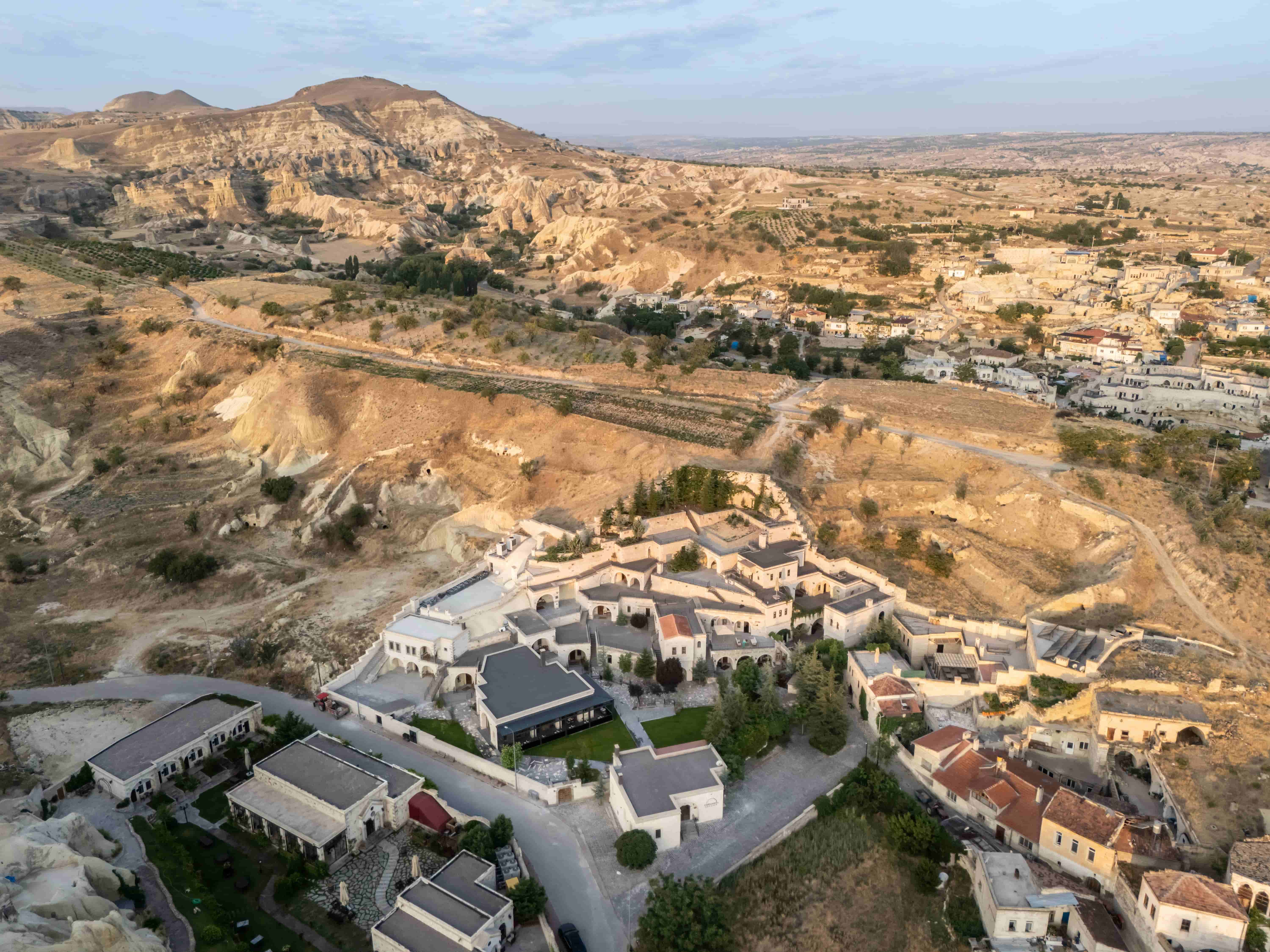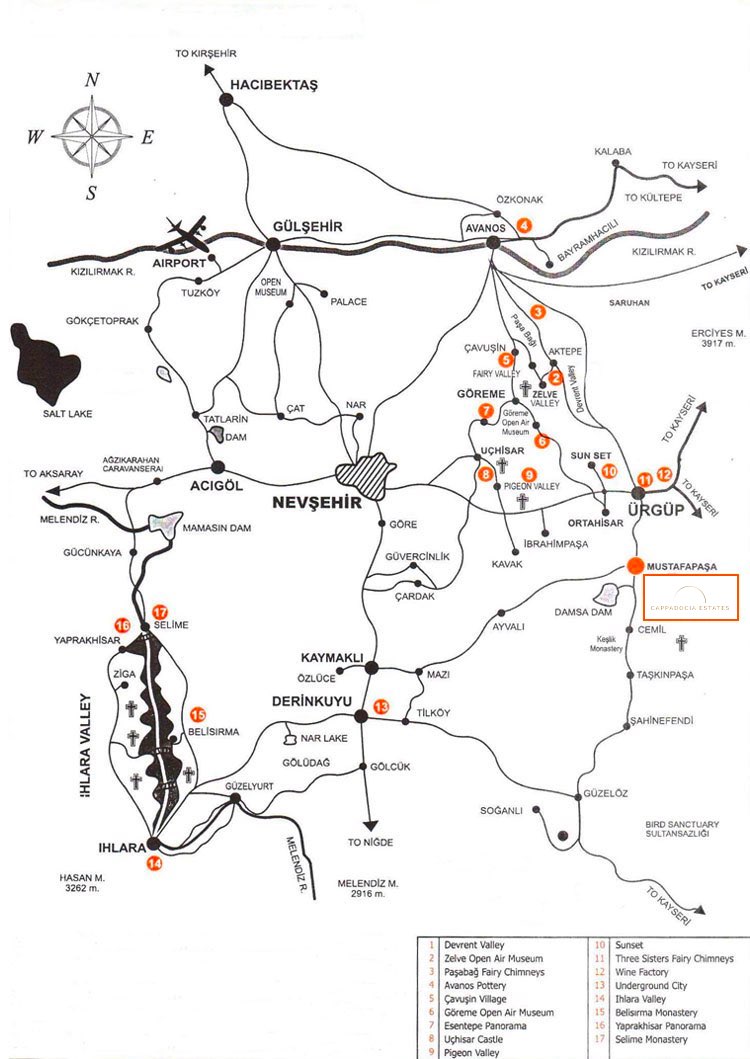
- WHAT IS CAPPADOCIA? -
With an unusual history, volcanic landscape, and a distinct lifestyle, Cappadocia is a surprisingly rewarding region to visit.
The biblical Cappadocia was large and occupied all of central Turkey; today’s Cappadocia as a travel destination is slightly smaller than Yellowstone National Park. So – it’s big!
It is dense with volcanic formations, underground cities, plenty of history, famous fairy chimneys, man-made underground cities, frescoed rock churches and colorful hot air balloons dotting the blue sky.
Geography of Cappadocia 101
Through thousands of years, several volcanoes blanketed the region with a thick layer of volcanic ash and rock. Ash was absorbed by the local soil and formed the soft rock called tuff. The volcanic rock was not absorbed but mostly remained as the top layer.
Wind, rain and snow water gradually eroded the land, only to leave behind parts of the hard, volcanic rock, and the tufa layer just underneath, partially protected (by the volcanic rock on top) from the erosion. This is how the fairy chimneys were born; softer tufa, capped with volcanic rock. Through time, the rock on top falls by tectonic activities, or by severe erosion and frost. And when this happens, the soft tufa body cannot survive for long. Without the protection of the harder volcanic rock on top, erosion wipes them away.
Erosion, on the other hand, is what keeps the cycle going. Older chimneys are wiped away, and new ones are coming into existence in massive accumulations of tufa. And it will go on as long as the wind blows and the rain falls.
GOOD TO KNOW
Cappadocia is a high desert. In all seasons day and night temperatures can be drastically different. For packing, appropriate seasonal layering is ideal. Shoes with good traction are necessary for dusty terrain, especially if you are planning to get away from the beaten path or walk through valleys.
CHRISTIANITY AND CAPPADOCIAN CHURCH FATHERS
Three Cappadocian learned men, from affluent, distinguished families, left their mark in early Christian history in the 4th century: Gregory of Nazianus, Basil the Great, and Gregory of Nyssa. Latter two were brothers. Brothers’ and their sister, Macrina, set the tone for pious Christians with their choices and lifestyles.
These sons of Cappadocia sealed all of Christian idea with their theological and philosophical approach, leaving a considerable legacy of writing that allowed scholars to study and appreciate their approach. Gregory of Nazianus and Basil the Great were from rich and foresighted families; this paved the road to their education. The brothers traveled from their homeland of Cappadocia to Alexandria, Athens, and Constantinople, eagerly studying classical Greek philosophy.
Gregory of Nyssa, also known as Gregory "the younger", decided not to follow the suit, and stayed in his native land. He studied under his dedicated sister, Macrina who had chosen to live a humble life and study Scripture, rejecting classical education. Her life and her influence on her family are the foundations of the ascetic Christian ideal.
To better appreciate the importance of Cappadocian Fathers, you will have to look into the issues causing divergence within the early church. A much-debated topic was the unity of God in the Holy Trinity; Christianity had inherited the Hebrew faith in one God, but also recognized Christ as the Son of God, and that he existed along with the Father and that God was never alone. Christ was the Son and Logos of God.
However, at the time of Cappadocian fathers, there was a belief that Father was unique and Christ was subordinate to God and there was a beginning of his existence. The capital, Constantinople was in favor of this thought, named Arianism.
Basil and Gregory were firm believers of the Nicean Creed and opponents of Arianism which, they believed, was dividing Cappadocia’s faithful Christians. They opposed Arian theologians in public debates. Although debates were lead by Arian presidents, Gregory and Basil were triumphant.
The winning statement of their advocacy brought an end to discussion about the nature of God in Orthodoxy. Father, Son, and the Holy Ghost form an unbreakable unity. The three are one God and can not be conceived apart from another, and they are in an unbreakable communion.
Besides the theology of Trinity, Cappadocian fathers have great influence in the liturgy, development of Christian ethics, and formation of monastic life by stressing communal living over solidarity. They spent their vast fortunes on poor and needy showing the uselessness of wealth if not spent for the good of the people.
The history generously acknowledge three great Cappadocian Fathers; but mentions of St. Macrina falls short of recognizing her input. It was probably Macrina who lead her family to the dedication of their wealth by embracing poor in the light of The Father, The Son, and the Holy Spirit.
